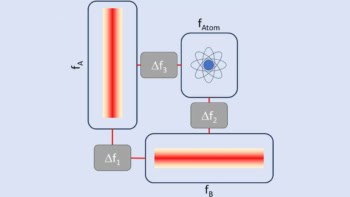People who can’t use their limbs to type will now be able to write electronic documents more easily and efficiently, thanks to a new text-entry system developed by two physicists at Cambridge University. The system relies on people using their eyesight to pick out letters displayed on a computer monitor, and uses language modelling to complete partly formed words (D Ward and D MacKay 2002 Nature 418 838). Meanwhile, a US physicist has recently developed an extension to Braille that allows blind people to read scientific papers.
A number of systems already exist that enable disabled people to write electronic documents by using cameras to interpret eye movements. But these tend to rely on users picking out letters by staring at the buttons of an on-screen keyboard. This is a tiring, laborious process.
In contrast, the system developed by David Ward and David MacKay at the Cavendish Laboratory in Cambridge — known as Dasher – divides the screen into boxes and allocates a certain letter to each box. The size of each box depends on the likelihood of the user choosing that particular letter, given the letters they have already chosen in the word they are writing. Since the system displays not only the boxes relating to the letter currently being chosen but also boxes containing the subsequent letters most likely to appear, the user can write words by navigating their way across the screen.
Ward and MacKay found that after an hour of practice, users of Dasher could write up to 25 words per minute, whereas people using on-screen keyboards were restricted to 15 words per minute. They also concluded that Dasher users were far less likely to make mistakes and were less stressed when using the system.
“Our system is well matched to the eye’s natural talent for search and navigation,” they say in their paper. “The eye did not evolve to push buttons.”
According to the Cambridge researchers, Dasher works in most languages and can also be operated using other pointing devices, such as a touchpad or rollerball. “Dasher is potentially an efficient, accurate and fun writing system not only for disabled computer users but also for users of mobile computers,” they say.
In a separate development, John Gardner, a blind physicist at the Oregon State University in the US, has created an extension of Braille known as Dots Plus. Gardner’s system represents complex mathematical symbols like integral signs simply by raising them in relief on the page rather than using Braille dots. Blind people can then print out these embossed symbols using a special printer, in the same way that sighted readers use a standard printer.
“I believe that information should be created and transmitted in a form that is as display-independent as possible,” says Gardner. “A very good Dots Plus user can probably read a scientific paper in about the same time as a sighted person.”



